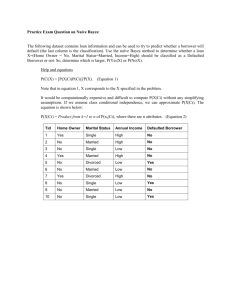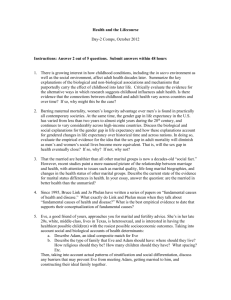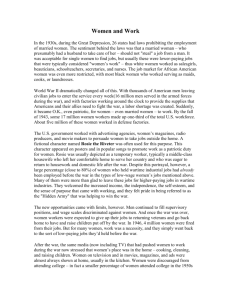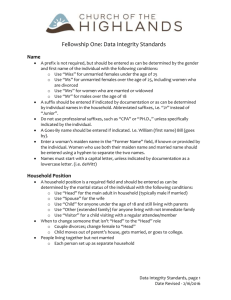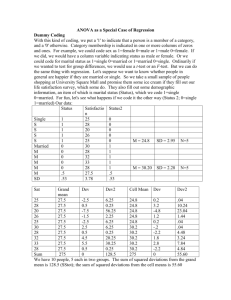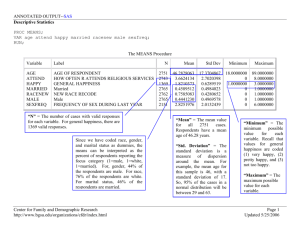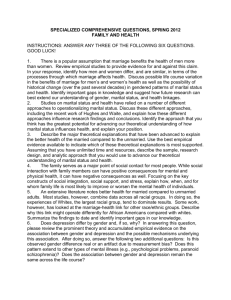ANNOTATED OUTPUT--SAS Simple Linear
advertisement
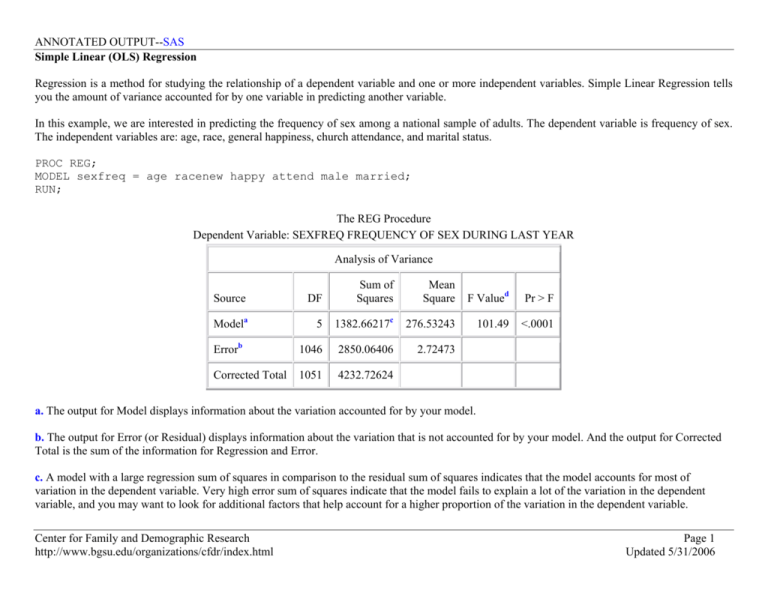
ANNOTATED OUTPUT--SAS Simple Linear (OLS) Regression Regression is a method for studying the relationship of a dependent variable and one or more independent variables. Simple Linear Regression tells you the amount of variance accounted for by one variable in predicting another variable. In this example, we are interested in predicting the frequency of sex among a national sample of adults. The dependent variable is frequency of sex. The independent variables are: age, race, general happiness, church attendance, and marital status. PROC REG; MODEL sexfreq = age racenew happy attend male married; RUN; The REG Procedure Dependent Variable: SEXFREQ FREQUENCY OF SEX DURING LAST YEAR Analysis of Variance Source DF Sum of Squares Mean Square F Valued Pr > F Modela 5 1382.66217c 276.53243 101.49 <.0001 Errorb 1046 2850.06406 2.72473 Corrected Total 1051 4232.72624 a. The output for Model displays information about the variation accounted for by your model. b. The output for Error (or Residual) displays information about the variation that is not accounted for by your model. And the output for Corrected Total is the sum of the information for Regression and Error. c. A model with a large regression sum of squares in comparison to the residual sum of squares indicates that the model accounts for most of variation in the dependent variable. Very high error sum of squares indicate that the model fails to explain a lot of the variation in the dependent variable, and you may want to look for additional factors that help account for a higher proportion of the variation in the dependent variable. Center for Family and Demographic Research http://www.bgsu.edu/organizations/cfdr/index.html Page 1 Updated 5/31/2006 ANNOTATED OUTPUT--SAS d. If the significance value of the F statistic is small (smaller than say 0.05) then the independent variables do a good job explaining the variation in the dependent variable. If the significance value of F is larger than say 0.05 then the independent variables do not explain the variation in the dependent variable. For this example, the model does a good job explaining the variation in the dependent variable. Root MSE 1.65067 R-Squaree 0.3267 Dependent Mean 2.75475 Adj R-Sq 0.3234 Coeff Var 59.92097 e. The “R Square” tells us how much of the variance of the dependent variable can be explained by the independent variable(s). In the case of Model 1, 20% of the variance in frequency of sex is explained by differences in age of respondent. Parameter Estimates DF Parameter Estimate Standard Error t Valueg Pr > |t|h Intercept 1 8.29800 0.29663 27.97 <.0001 AGE AGE OF RESPONDENT 1 -0.05550 0.00304 -18.26 <.0001 MARITAL MARITAL STATUS 1 -1.37233 0.10713 -12.81 <.0001 RACENEW NEW RACE RECODE 1 -0.21538 0.12527 -1.72 0.0859 ATTEND HOW OFTEN R ATTENDS RELIGIOUS SERVICES 1 -0.06743 0.01962 -3.44 0.0006 HAPPY GENERAL HAPPINESS 1 -0.26184 0.08464 -3.09 0.0020 Variable Label Interceptf f. The “intercept” variable represents the Y-intercept, the height of the regression line when it crosses the Y axis. In this example, it is the predicted value of “frequency of sex” when all other values are zero (0). Center for Family and Demographic Research http://www.bgsu.edu/organizations/cfdr/index.html Page 2 Updated 5/31/2006 ANNOTATED OUTPUT--SAS g. The t statistics can help you determine the relative importance of each variable in the model. As a guide regarding useful predictors, look for t values well below -2 or above +2. For example, for “race” t = 1.72 and not significant. h. The significance column indicates whether or not a variable is a significant predictor of the dependent variable. For example, the race variable is not significant, while the other variables are significant. Center for Family and Demographic Research http://www.bgsu.edu/organizations/cfdr/index.html Page 3 Updated 5/31/2006 ANNOTATED OUTPUT--SAS Regression Equation SEXFREQpredicted = 8.298 – .056*age – 1.372*marital - .215*race – .262*happy – .067*attend For instance, if we plug in values in for the independent variables (age = 35 years; marital = currently married-1; race = white-1; happiness = very happy-1; church attendance = never attends-0), we can predict a value for frequency of sex: SEXFREQpredicted = 8.298 – .056*35 – 1.372*1 - .215*1 – .262*1 – .067*0 = 4.489 As this variable is coded, a 35-year old, White, married person with high levels of happiness and who never attends church would be expected to report their frequency of sex between values 4 (weekly) and 5 (2-3 times per week). If we plug in 70 years, instead, we find that frequency of sex is predicted at 2.529, or approximately 1-2 times per month. Model Interpretation Intercept = The predicted value of “frequency of sex”, when all other variables are 0. In this example, a value of 8.298 is not interpretable, since the valid responses for frequency of sex range from 0-6. Important to note, values of 0 for all variables is not interpretable either (i.e., age cannot equal 0). Age = For every unit increase in age (in this case, year), frequency of sex will decrease by .056 units. Marital Status = For every unit increase in marital status, frequency of sex will decrease by 1.372 units. Since marital status has only two categories, we can conclude that currently married persons have more sex than currently unmarried persons. Race = For every unit increase in race, frequency of sex will decrease by .215 units. Since race has only two categories, we can conclude that nonWhite persons have more sex than White persons. Happiness = For every unit increase in happiness, frequency of sex will decrease by .262 units. Recall that happiness is coded such that higher scores indicate less happiness. For this example, then, higher levels of happiness predict higher frequency of sex. Church Attendance = For every unit increase in church attendance, frequency of sex decreases by .067 units. Center for Family and Demographic Research http://www.bgsu.edu/organizations/cfdr/index.html Page 4 Updated 5/31/2006 ANNOTATED OUTPUT--SAS Simple Linear Regression (with non-linear variable) PROC REG; MODEL sexfreq = age marital racenew happy church agesquar; RUN; It is known that some variables are often non-linear, or curvilinear. Such variables may be age or income. In this example, we include the original age variable and an age squared variable. Parameter Estimates DF Parameter Estimate Standard Error t Value Pr > |t| Intercept 1 7.46680 0.49979 14.94 <.0001 AGE AGE OF RESPONDENT 1 -0.02050 0.01722 -1.19 0.2343 MARITAL MARITAL STATUS 1 -1.31425 0.11060 -11.88 <.0001 RACENEW NEW RACE RECODE 1 -0.21831 0.12508 -1.75 0.0812 HAPPY GENERAL HAPPINESS 1 -0.27140 0.08464 -3.21 0.0014 ATTEND HOW OFTEN R ATTENDS RELIGIOUS SERVICES 1 -0.06707 0.01959 -3.42 0.0006 1 -0.00035233 0.00017065 -2.06 0.0392 Variable Label Intercept AGESQUARi i. The age squared variable is significant, indicating that age is non-linear. Center for Family and Demographic Research http://www.bgsu.edu/organizations/cfdr/index.html Page 5 Updated 5/31/2006 ANNOTATED OUTPUT--SAS Simple Linear Regression (with interaction term) In a linear model, the effect of each independent variable is always the same. However, it could be that the effect of one variable depends on another. In this example, we might expect that the effect of marital status is dependent on gender. In the following example, we include an interaction term, male*married. To test for two-way interactions (often thought of as a relationship between an independent variable (IV) and dependent variable (DV), moderated by a third variable), first run a regression analysis, including both independent variables (IV and moderator) and their interaction (product) term. It is highly recommended that the independent variable and moderator are standardized before calculation of the product term, although this is not essential. For this example, two dummy variables were created, for ease of interpretation. Gender was coded such that 1=Male and 0=Female. Marital status was coded such that 1=Currently married and 0=Not currently married. The interaction term is a cross-product of these two dummy variables. Center for Family and Demographic Research http://www.bgsu.edu/organizations/cfdr/index.html Page 6 Updated 5/31/2006 ANNOTATED OUTPUT--SAS Regression Model (without interactions) PROC REG; MODEL sexfreq = age racenew happy attend male married; RUN; Parameter Estimates DF Parameter Estimate Standard Error t Value Pr > |t| Variable Label Intercept Intercept B 7.93136 0.31097 25.51 <.0001 AGE AGE OF RESPONDENT 1 -0.05477 0.00303 -18.09 <.0001 MARITAL MARITAL STATUS B -1.31795 0.10748 -12.26 <.0001 RACENEW NEW RACE RECODE 1 -0.23077 0.12458 -1.85 0.0643 HAPPY GENERAL HAPPINESS 1 -0.24217 0.08430 -2.87 0.0042 ATTEND HOW OFTEN R ATTENDS RELIGIOUS SERVICES 1 -0.05626 0.01974 -2.85 0.0045 MALE Male 1 0.38525 0.10387 3.71 0.0002 MARRIED Married 0 0 . . . Center for Family and Demographic Research http://www.bgsu.edu/organizations/cfdr/index.html Page 7 Updated 5/31/2006 ANNOTATED OUTPUT--SAS Regression Model (with interactions) PROC REG; MODEL sexfreq = age racenew happy attend male married interact; RUN; Parameter Estimates DF Parameter Estimate Standard Error t Value Pr > |t| Variable Label Intercept Intercept 1 4.90172 0.24802 19.76 <.0001 AGE AGE OF RESPONDENT 1 -0.05387 0.00306 -17.63 <.0001 RACENEW NEW RACE RECODE 1 -0.22534 0.12409 -1.82 0.0697 HAPPY GENERAL HAPPINESS 1 -0.23012 0.08389 -2.74 0.0062 MALE Male 1 0.72980 0.13809 5.29 <.0001 MARRIED Married 1 1.60935 0.14769 10.90 <.0001 INTERACT Interact 1 -0.67733 0.20924 -3.24 0.0012 The product term should be significant in the regression equation in order for the interaction to be interpretable. Regression Equation SEXFREQpredicted = 4.902 -.054*age - .225*race -.230*happy + 1.609*married + (.730 - .677*married) * male Interpretation Main Effects The married coefficient represents the main effect for females (the 0 category). The effect for females is then 1.61, or the “marital” coefficient. The effect for males is 1.61 - .68, or .93. Center for Family and Demographic Research http://www.bgsu.edu/organizations/cfdr/index.html Page 8 Updated 5/31/2006 ANNOTATED OUTPUT--SAS The gender coefficient represents the main effect for unmarried persons (the 0 category). The effect for unmarried is then .73, or the “sex” coefficient. The effect for married is .73 - .68, or .05. Interaction Effects For a simple interpretation of the interaction term, plug values into the regression equation above. Married Men = Married Women = Unmarried Men = Unmarried Women = SEXFREQpredicted = 4.902 -.054*age - .225*race -.230*happy + 1.609*1 + (.730 - .677*1) * 1 SEXFREQpredicted = 4.902 -.054*age - .225*race -.230*happy + 1.609*1 + (.730 - .677*1) * 0 SEXFREQpredicted = 4.902 -.054*age - .225*race -.230*happy + 1.609*0 + (.730 - .677*0) * 1 SEXFREQpredicted = 4.902 -.054*age - .225*race -.230*happy + 1.609*0 + (.730 - .677*0) * 0 = 4.219 = 4.166 = 2.610 = 2.557 In this example (age = 35 years; race = white-1; happiness = very happy-1; church attendance = never attends-0), we can see that (1) for both married and unmarried persons, males are reporting higher frequency of sex than females, and (2) married persons report higher frequency of sex than unmarried persons. The interaction tells us that the gender difference is greater for married persons than for unmarried persons. Center for Family and Demographic Research http://www.bgsu.edu/organizations/cfdr/index.html Page 9 Updated 5/31/2006

